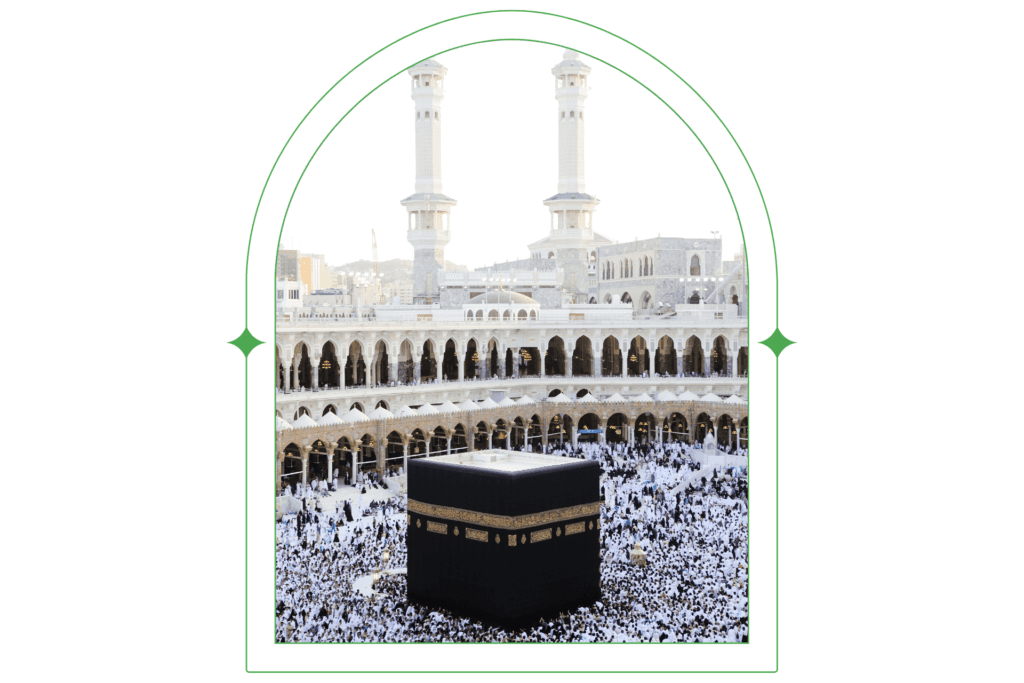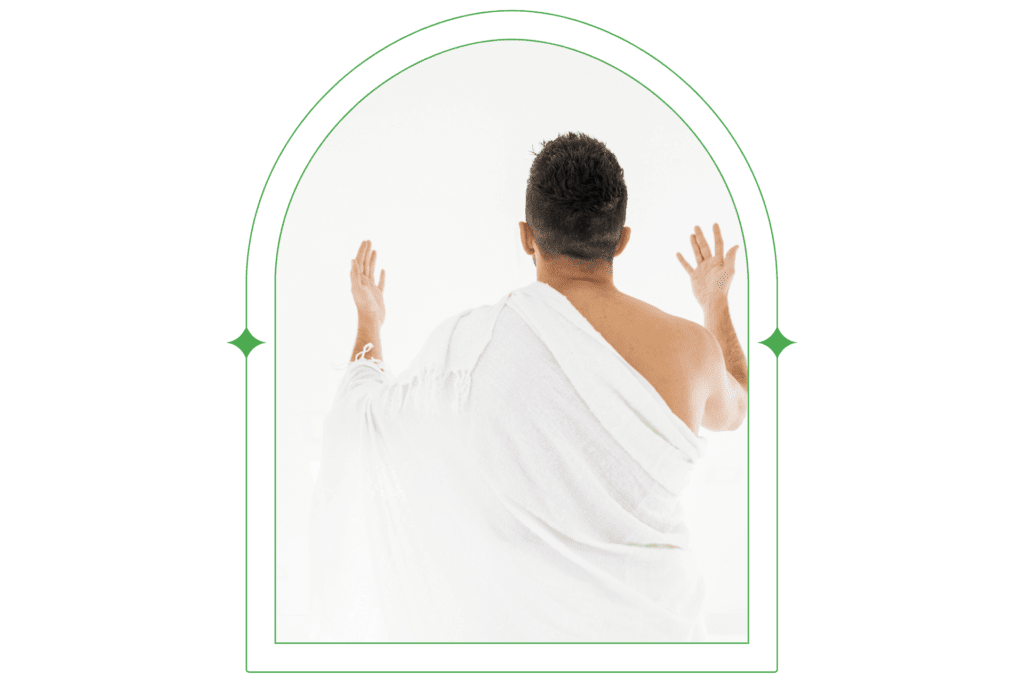-
Home
/
- How To Perform Umrah

How to perform umrah:
Everything you need to know
Umrah is a voluntary pilgrimage that holds great spiritual significance for Muslims worldwide. At Hajj With Ayesha, our comprehensive step-by-step manual will ensure that you perform Umrah with utmost dedication and comprehension.
The rituals of Umrah center around the sacred city of Makkah and the Kaaba, the holiest site in Islam. As you embark on this sacred journey to the holy city of Makkah, allow us to be your loyal companion, providing you with all the necessary information and assistance to make your Umrah experience truly unforgettable.

Step 1:
Entering the sacred city
As you set foot in the revered city of Makkah, a profound sense of wonder and veneration engulfs the atmosphere. The sanctity of this place envelops you, and your heart swells with anticipation and appreciation.
An Enchanting Glimpse of Makkah and the Kaaba: Upon your arrival in Makkah, catch your very first sight of the Kaaba, the sacred abode of Allah, and experience an overwhelming wave of spirituality. Take a moment for prayers and introspection, expressing heartfelt gratitude for this blessed opportunity.
Etiquette and Decorum: Uphold the principles of etiquette and decorum while in this holy city. Respect the sanctity of the surroundings, display kindness towards fellow pilgrims, and adhere to the local customs and regulations.

Step 2:
The Niyyath
For Umrah, it is recommended (Mustahab) to express your intention both verbally and internally at the Miqat or in its vicinity as you proceed towards it.
The Arabic intentions provided below serve as examples:
اللَّهُمَّ إِنِّيْ أُرِيْدُ الْعُمْرَةَ
Meaning: O Allah, I desire to fulfill the Umrah.
اللَّهُمَّ إِنِّيْ أُرِيْدُ الْعُمْرَةَ فَيَسِّرْهَا لِيْ وَتَقَبَّلْهَا مِنِّيْ
Meaning: O Allah, I desire to perform Umrah, so make it easy for me and accept it from me.

Step 3:
Ihram
Before embarking on the sacred journey of Hajj, pilgrims must cleanse and purify themselves. During the state of Ihram, male pilgrims will don two seamless attires, while female pilgrims will don modest, flowing garments. It is recommended, as part of the Sunnah, to perform two Rakahs of Salah before entering the state of Ihram.
Step 4:
Reciting Talbiyah
To affirm your purpose and embrace the state of Ihram, it is essential to recite the Talbiyah after making your Niyyath. The schools of thought, namely Hanafi and Maliki, both concur that the recitation of the Talbiyah statement is wajib.
The Talbiyah is as follows:
لَبَّيْكَ اللهُمَّ لَبَّيْكَ – لَبَّيْكَ لَا شَرِيْكَ لَكَ لَبَّيْكَ – إِنَّ الْحَمْدَ وَالنِّعْمَةَ لَكَ وَالْمُلْكَ – لَا شَرِيْكَ لَكَ
This can be pronounced as:
“Labbayk allahumma labbayeek, labbayeeka l’aa sharika laka labbayeek, innal-ḥamda wan-ni’mata, laka wal-mulk, l’aa sharika lak.”
The meaning of the Talbiyah is:
“Oh Allah, here I am at Your service, here I am. You have no partner. Truly all praise, favor, and sovereignty belong to You. You have no partner.”
Feel free to recite this sacred invocation as you embark on your spiritual journey.
Step 5:
Tawaf
Embark on your Umrah journey by engaging in the sacred act of Tawaf, which entails completing seven revolutions around the revered Kaaba. This profound ritual symbolizes harmony and unwavering dedication to the Supreme Being.
Step 6:
Sa'i
Continue the Tawaf with Sa’i, walking seven times between the hills of Safa and Marwah. This ritual commemorates Hajar (AS)’s quest for water for her son Isma’il and symbolizes strength, perseverance and devotion.
To ensure the Sa’i is considered valid, the following requirements must be met:
- Perform Sa’i on oneself
- Complete the Sa’i after entering the state of Ihram
- Remain in the state of Ihram until the completion of Sa’i
- Perform Sa’i at the appropriate time
- Start Sa’i at Safa and conclude at Marwa
- Conduct Sa’i after completing the Tawaf
- Undertake Sa’i on foot (unless there is a legitimate reason)
- Complete seven rounds of Sa’i
Step 7:
Halq or Taqsir
Fulfill your Umrah rituals by shaving your hair (for men) or trimming the length of your hair (for women). This gesture symbolizes modesty and the rejuvenation of one’s inner self in the devoted service of Allah. Opting for a complete shaving of the head is considered highly commendable for men.
Step 8:
Exploring the Masjid an-Nabawi
If your itinerary permits, seize the chance to explore the revered city of Madinah and partake in prayers at the Prophet Muhammad (SAW)’s Mosque (Masjid an-Nabawi). Embrace the divine aura of this holy place and show reverence at the final resting place of the esteemed Prophet Muhammad (SAW).
Step 9:
Optional acts of devotion
Devoting time to I’tikaf : During the final ten days of Ramadan, consider engaging in I’tikaf (spiritual seclusion) at the Grand Mosque in Makkah or other mosques to attain heightened spiritual blessings.
Offering prayers at Mount Arafat and Muzdalifah: If your Umrah coincides with the Hajj season, participate in certain Hajj rituals, such as standing at Mount Arafat and spending the night in Muzdalifah.
Extra Tawaf and Sa’i: Perform additional circuits around the Kaaba and extra rounds between Safa and Marwa to demonstrate gratitude and unwavering devotion to Allah.
Frequently Asked Questions
What are the steps involved in performing Umrah?
Ihram: Enter the sacred state by wearing specific clothing and making an intention.
Tawaf: Perform seven rounds of circumambulation around the Kaaba.
Sa'i: Walk seven times between Safa and Marwah.
Taqsir: Complete Umrah by shaving or trimming hair.
How should I prepare for Umrah?
What actions and behaviors should be refrained from during Umrah?
While performing Umrah, it is advisable to abstain from certain activities and conduct. These include refraining from trimming hair or nails, using perfumes, hunting, engaging in physical relations, getting involved in arguments or using offensive language, as well as avoiding any other behaviors that are prohibited while in the state of Ihram, which is the sacred state of pilgrimage.
Is it necessary to perform Wudu for Umrah?
While it is not obligatory, it is strongly advised to be in a state of Wudu while participating in Tawaf (circumambulation around the Kaaba) and performing prayers during the pilgrimage.
